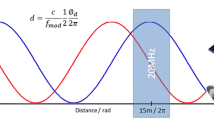Abstract
In this paper, we propose a highly accurate way to simulate Time-of-Flight sensors and their explicit characteristics, those enabling sensor evaluations for critical applications, like measurement scenarios, human-machine-collaboration and autonomous driving, as well as a way for estimation of the best-suited sensor for a specific use case. A. Schütz did the development of the simulation, while M. Groneberg was focused on the application of such simulation to logistics. Time-of-Flight Sensors are able to provide robust depth images of dynamic scenes at high framerates, which makes them interesting for movement analysis and logistics use cases and makes them advantageous for autonomous mobile robot navigation. Yet the depth images are disrupted by a number of systematic errors, which, to our knowledge, have not been fully simulated so far. These errors has to be taken into account in early development stages to avoid the destruction of hardware or injuring humans working with autonomous robots. We believe that simulations are suited to develop and to test algorithms for navigation under different environmental conditions to avoid errors, which are caused by misleading depth images. This paper examines the systematic errors of three different Time-of-Flight sensors and presents a physically motivated approach to simulate those sensors. We were able to simulate most of the systematic errors, which were observed in depth images of time-of-flight sensors by using a path tracing algorithm to calculate the influence of light propagation in a physically accurate manner.
Access this chapter
Tax calculation will be finalised at checkout
Purchases are for personal use only
Similar content being viewed by others
References
Li, L.: Time-of-flight camera - an introduction. Texas Instruments-Technical White Paper (2014)
Meister, S.: Photon mapping based simulation of multipath reflection artifacts in time-of-flight sensors (2012)
Schütz, A.: Analyse und Simulation von Time-of-Flight Sensoren mittels GPU Path Tracing (2019)
Giancola, S., Valenti, M., Sala, R.: A Survey on 3D Cameras: Metrological Comparison of Time-of-Flight, Structured-Light and Active Stereoscopy Technologies. Springer, Heidelberg (2018)
Hertzberg, C., Frese, U.: Detailed modeling and calibration of a time-of-flight camera. In: Proceedings of the 11th International Conference on Informatics in Control, Automation and Robotics. SCITEPRESS - Science and and Technology Publications (2014)
Jamtsho, S., Lichti, D.: Modelling scattering distortion in 3D range camera. Int. Arch. Photogrammetry Rem. Sens. Spat. Inf. Sci. 38, 299–304 (2010)
Mure-Dubois, J.C.C., Hügli, H.: Optimized scattering compensation for time-of-flight camera - Art. no. 67620 h, September 2007
Mure-Dubois, J.C.C., Hügli, H.: Time-of-flight imaging of indoor scenes with scattering compensation, January 2009
Meister, S., Nair, R., Kondermann, D.: Simulation of time-of-flight sensors using global illumination (2013)
Lambers, M., Hoberg, S., Kolb, A.: Simulation of time-of-flight sensors for evaluation of chip layout variants. IEEE Sens. J. 15(7), 4019–4026 (2015)
Kajiya, J.T.: The rendering equation. In: Proceedings of the 13th Annual Conference on Computer Graphics and Interactive Techniques (SIGGRAPH) 1986. ACM Press (1986)
Oren, M., Nayar, S.K.: Generalization of lamberts reflectance model. In: SIGGRAPH (1994)
Groneberg, M., Brauckmann, N., Richter, K.: Infrastructure-Free Sensor Platform for Multidimensional Object and Motion Analysis. RelStat, October 2019
Fast. https://de.fast-zwanzig20.de/. Accessed 27 July 2019
Acknowledgements
The authors acknowledge the Federal Ministry of Education and Research Germany for financial support within the framework of the zwanzig20 program. https://de.fast-zwanzig20.de/.

Author information
Authors and Affiliations
Corresponding author
Editor information
Editors and Affiliations
Rights and permissions
Copyright information
© 2020 The Editor(s) (if applicable) and The Author(s), under exclusive license to Springer Nature Switzerland AG
About this paper
Cite this paper
Schütz, A., Groneberg, M. (2020). Sensor Simulation and Evaluation for Infrastructure-Free Mobile Sensor Carrier Platforms. In: Freitag, M., Haasis, HD., Kotzab, H., Pannek, J. (eds) Dynamics in Logistics. LDIC 2020. Lecture Notes in Logistics. Springer, Cham. https://doi.org/10.1007/978-3-030-44783-0_10
Download citation
DOI: https://doi.org/10.1007/978-3-030-44783-0_10
Published:
Publisher Name: Springer, Cham
Print ISBN: 978-3-030-44782-3
Online ISBN: 978-3-030-44783-0
eBook Packages: EngineeringEngineering (R0)




